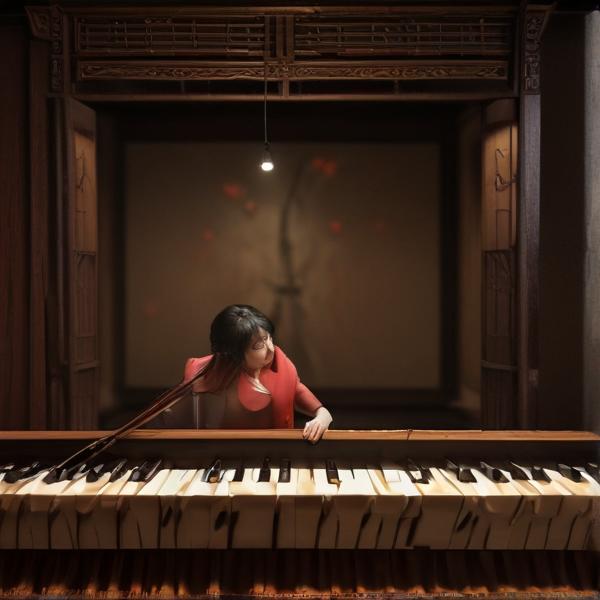基本信息 (Basic Information)
含义与用法 (Meanings & Usage)
中文核心释义 (Core Chinese Meaning): 弯,弯曲;歌曲,乐曲
英文核心释义 (Core English Meaning): bent, curved; tune, melody, song
象形意义 / 为何这么写 (Pictographic Meaning / Writing Rationale)
文言文释义 (Classical Chinese Meaning)
与现代意义相近,主要有“弯曲”与“乐曲”的意思,也用作姓氏。Similar to modern meaning; mainly refers to 'bending/curved' or 'melody/song.' Sometimes used as a surname.
深入学习 (In-depth Study)
字源故事 (Origin Story)
字形演变 (Character Evolution)
常用词语和例句 (Common Words & Examples)
曲线 (curve; curved line)
这条曲线非常优美。
Eng: This curve is very beautiful.
歌曲 (song)
他唱了一首动人的歌曲。
Eng: He sang a touching song.
弯曲 (to bend; curved)
这条河流弯曲曲折。
Eng: This river is winding and curved.
相关成语 (Related Idioms)
委曲求全
Meaning: to compromise to achieve an overall good; to bend for the sake of the greater good
多语言翻译 (核心释义) (Translations (Core Meaning))
- French: courbe; air, mélodie
- German: Kurve; Melodie, Lied
- Spanish: curva; melodía, canción
- Italian: curva; melodia, canzone
- Portuguese: curva; melodia, canção
- Russian: изгиб; мелодия, песня
- Arabic: منحنى؛ لحن، أغنية
- Persian: منحنی؛ ملودی، آهنگ
- Dutch: bocht; melodie, lied
- Polish: krzywa; melodia, piosenka
- Vietnamese: đường cong; giai điệu, bài hát
- Ukrainian: крива; мелодія, пісня
视频学习资源 (Video Learning Resources)
通过以下链接在热门视频网站搜索 "曲" 的更多讲解:
Search for more explanations of "曲" on popular video sites:
- 在 Bilibili.com 搜索 "曲 字源 说文解字" (Search on Bilibili)
- 在 YouTube.com 搜索 "qu character origin etymology" (Search on YouTube)
网络参考 (Web References for "曲") ()
网络内容摘要 (Web Content Summary):
“曲”字的核心含义与象形起源: “曲”最初的字形来自象形,像是一把“曲尺”(弯曲的尺子)的形状。在甲骨文、金文等古文字中,字形都表现出弯曲的特色。因此,“曲”的本义是指弯曲、不直的事物。 Core meaning and pictographic origin: The character “曲” originally comes from a pictograph resembling a carpenter’s square (quchi) or a bent object. In oracle bone and bronze inscriptions, its form shows a clear bent shape. Thus, the basic meaning is “bent” or “not straight.”
文化背景及引申用法: 古时,“曲”还可以表示一种养蚕或装物的弯曲器具,因为制作这些器具要把材料弯成曲形。此外,“曲”引申为音乐、歌唱等义,如“乐曲”(music piece)、“曲艺”(folk art performance),也用于指委屈(如“委曲求全”)。 Cultural and extended meanings: In ancient times, “曲” also referred to a curved tool for raising silkworms or storing items, reflecting its bent form. Later, it extended to mean music, melodies, and sometimes “injustice” or “feeling wronged” (as in “委曲求全” – to compromise for the greater good).
- 常见词/成语: “歌曲” (song), “曲线” (curve), “曲折” (twist/complication), “委曲求全” (to compromise). Common words/idioms: “歌曲” (song), “曲线” (curve), “曲折” (twist or complication), “委曲求全” (to compromise for the overall good).
- 易混淆点: “曲”有时与“直”(straight)相对,另有“曲解”表示误解或歪曲他人意思。 Common confusion: “曲” is often the opposite of “直” (straight). It also appears in phrases like “曲解” (to misinterpret or distort someone's meaning).
曲字形演变字源_汉字「曲」_曲的甲骨文_曲的金文_金文编_甲骨文编
甲骨文「曲」字作 ,像曲尺之形,是「曲」字初文。 後金文作 ,框內稍有繁簡,或逕省去文飾作 。 戰國古璽作 、楚簡作 ,承金文曲尺之象,皆為古文 之來源。 有時也作橫置作 ,則為篆文之所取象。 秦簡文字作 ,並見於馬王堆帛書,皆從 ,中實以「 」。 在六書中屬於異文會意。
汉字"曲"的起源、演变过程-汉字字源辞典
汉字字源辞典收录721条汉字词条,基本涵盖了常见汉字的字源解析,是汉字研究的必备工具。 ... "曲"的本义就是养蚕的器具,或者是装物的筐笼,编制时要将材料弄弯,故此引申为弯曲、不直的意思,又可以引申为乐曲,段玉裁说:"谓音宛曲而成章也。 ...
更多图片 (曲 More Images) ()
